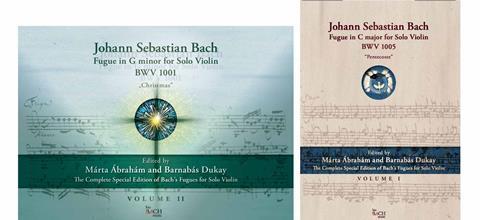Robin Stowell reviews the first two volumes in Biobach Music’s details edition of Bach’s fugues

The Complete Special Edition of Bach’s Fugues for Solo Violin: Vol.1
(Fugue in C major BWV1005 ‘Pentecoste’) and Vol.2 (Fugue in G minor BWV1001 ‘Christmas’)
Eds. Márta Ábrahám, Barnabás Dukay
Vol.1: 22PP ISMN 9790801675514 €24
Vol.2: 40PP ISMN 9790801675859 €24
BIOBACH MUSIC
Franz Liszt Academy violin professor Márta Ábrahám and composer Barnabás Dukay’s editions do not venture quite into ‘the sphere of exotic beliefs’ encountered by Tully Potter in their examination of Bach’s Ciaccona (from BWV1004; see the March 2019 issue), but they do link the fugues spiritually to major Christian feasts with sub-titles that have no origin with Bach. Further, in addition to Bach’s well-documented exploitation of numerology (vol.1) and the ‘golden ratio’ (vol.2), the editorial introductions (in English and Hungarian) comment on a wide range of symbolism inherent in his works and draw some conclusions that will be roundly disputed. Granted, the C major Fugue’s theme is based on the chorale ‘Komm, Gott Schöpfer, Heiliger Geist’, which itself originates from the Pentecostal Gregorian hymn ‘Veni Creator Spiritus’, but there is no similar derivation for the G minor Fugue to ‘suggest a connection’ with Christmas, nor is the fact that Corelli’s ‘Christmas Concerto’ shares the same key a valid justification. Questionable, too, is these editors’ very individual approach to fugal analysis: by claiming (vol.2) that there has previously been ‘no uniformly accepted vocabulary’ for such study, they discount the publications of Bach-circle theorists such as F. W. Marpurg (Abhandlung von der Fuge, 1753-4), even though they employ the Latin versions of Marpurg’s terms such as ’Führer (dux)’ and ’Gefährte (comes)’ to denote the status and roles in the genre of the principal thematic material.
This projected three-volume series’ sub-title, ‘From chaos to order’, refers to its organisation of Bach’s complex, single-stave polyphony by means of a discrete visual approach. Rather than using traditional analytical terminology, the editors consider fugue as ‘a dual system’ comprising a ‘Thematic Area’ and ‘Interlude Area’ (which may be ‘thematic’ or ‘divertimento-type’). Their use of coloured notation (seven different colours in BWV1001) to pinpoint the individual voices of the fugues demonstrates clearly both the hierarchical arrangement of Bach’s part writing and the overall architectural detail. Their analysis, though idiosyncratic, seems sound enough, dissecting the fugues for a clearer understanding of the often dense polyphony (particularly in passages of stretto), so that violinists may reconstruct them coherently and convincingly in their performances. They subdivide the C major Fugue, for example, into 7 main sections, comprising 3 episodes (‘interludes’) and 4 ‘thematic’ parts; they indicate that sections 1 and 7 and 4 and 6 are closely related, sections 2 and 3 are respectively the shortest and longest, and section 5, based on the fugue theme’s inversion, stands alone. Further elucidation is provided by their annotation of themes in ‘Thematic Areas’ with Roman numerals and those in ‘Interlude Areas’ with Arabic numbers.
Unlike the Ciaccona publication mentioned above, these editions do not include an accompanying CD of performances by Ábrahám. However, the editors and publishers have clearly given careful consideration to matters of presentation, often with practicalities of performance in mind. The score for BWV1005 (A4 portrait), for example, is laid out in four three-page spreads in accordance with the seven sections of the editors’ analysis; but the reason for the adoption of a conventionally paginated A4 landscape format for BWV1001 is not clearly evident. Further, volume 2’s separate list of ‘Thematic’ and ‘Interlude’ themes, included as an appendix inserted in a pocket on the inside of the back cover, seems superfluous. Nevertheless, the printed musical texts undoubtedly offer a clear visual representation of the structural framework and inner detail of each fugue, admirably demonstrating their coherence and facilitating prospective performers’ appreciation and comprehension of Bach’s compositional processes. The final volume of the trilogy, examining the fugue of BWV1003, has recently been published as well.
ROBIN STOWELL










































No comments yet